Experimental "divided-line reefing"
The idea behind this project is not mine but was published by Frank Marsden in Practical Boat Owner (September 2005, p140). It consists of four reef lines (luff reef + leach reef for the first and second reefs, respectively) which are led down to the cockpit via a number of turning blocks. There is nothing new about this, of course, but the unique feature is that the four lines are "spliced" together into a single rope at the hauling end. The reduced number and length of lines in the cockpit, is one obvious advantage. The reefing procedure is this:
In our case there was also another more serious problem: The stack of luff slides collected at the bottom of the mast is to weak to withstand the strong downforce necessary in the reef line. During testing in mild wind conditions one slide simply broke, and later the steel tongue latch that keeps the slides from sliding back out folded, which led to several slides dropping out spontaneously. No good... It it obvious that this reefing system has potential, but needs further refinements in order to become seaworthy, at least in our implementation.
+ The mainsail is lowered as usual until the cringles are low enough.
+ The single reef line is pulled in through its wide mouthed clutch until tight, bringing all four lines with it equally. The first reef is now set. Putting in this reef simultaneously takes out the slack from the second reef.
+ When it's time to set the second reef this pair of lines (the blue ones in the pictures below) are grabbed and hauled tight also. Theoretically the clutch should now hold all four lines firmly, but as it turned out some slippage was unavoidable (testing with a "squarish" Barton clutch and a Spinlock XL). This was remedied provisionally by adding a pair of metal clamleats inline.
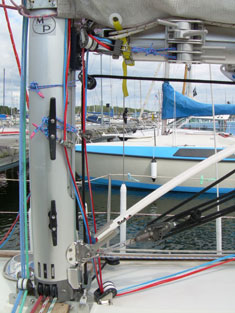 |
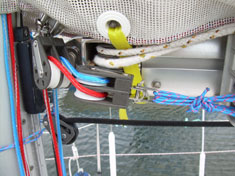 |
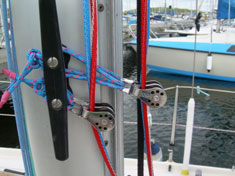 |
|
 |
 |
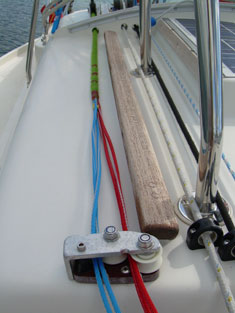 |
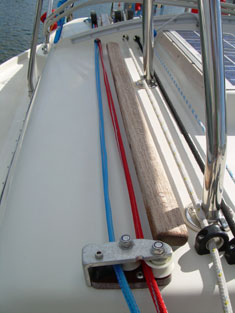 |
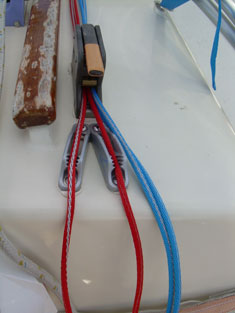 |
 |
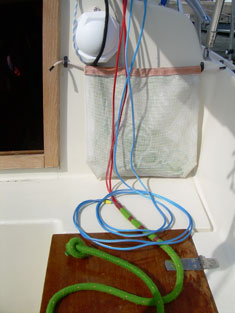 |
Test av revningssystem med delad lina
Den här idéen läste jag om i den brittiska tidskriften Practical Boat Owner (september 2005, sid 140). Tanken är alltså att två par revlinor (förliksrev + akterliksrev för första respektive andra revet) leds ned till sittbrunnen via diverse block. Detta är ju inget nytt, men det speciella är att dessa fyra linor samlas till en enda revlina i haländan. På det sättet slipper man bl a trasslet med fyra olika linor som kommer i vägen när det inte används. När man vill reva fungerar det så här: I vårt fall finns ett annat problem som gör att det här systemet antagligen inte skulle funka riktigt pålitligt i s k "skarpt läge", nämligen det faktum att "traven" med plasttravare som packas i likrännans nederdel inte tål att den genomgående revlinan sätts an så hårt som egentligen behövs. Vid test sprack först en travare, senare vek sig spärrblecket på masten så att alla de understa travarna rasade ur. Det är alltså uppenbart att systemet kräver mer utveckling för kunna sägas vara sjövärdigt, åtminstone med vårt utförande.
+ Storen sänks i vanlig ordning tills första revets löddror ligger på lagom höjd.
+ Man drar så haländan genom avlastaren tills det tar stopp: då är första revets linor satta. Andra revets linor följer samtidigt med så att inget slack uppstår i dessa.
+ Behöver man ta in även det andra revet (de blå linorna på bilderna ovan) så tar man tag i dessa två linor och drar hem dessa så mycket det går (efter att ha sänkt storen ytterliggare, förstås). Teoretiskt skall avlastaren nu knipa jämt över alla fyra linor, men detta fungerade inte tillfredställande för mig, och därför kompletterade jag med ett par extra clamcleats "in-line".